PLS 595 Pea Seed
PLS 595 Pea Seed
Couldn't load pickup availability
Seed Type
Seed Type
Open Pollinated (Untreated)
Seeds Per Pack
Seeds Per Pack
100
Days to Maturity
Days to Maturity
65
Disease Resistance
Disease Resistance

Why Grow PLS 595 Pea?
Sweet & Delicious PLS 595 is an "English" pea or sweet pea variety that was designed for superior performance and exceptional yields in backyard gardens. This versatile variety exhibits vigorous growth, large pods, sweet peas, and adaptability to a wide range of growing conditions. The peas have a compact, growth habit which makes them a great option for raised beds or an in-ground garden without the need for an extensive trellising system.
Reliable and Consistent Whether you're a seasoned gardener or a beginner, PLS 595 peas offer a reliable and rewarding gardening experience. Each plant node produces two pods, which average 10-12 peas per pod. The plants are resistant to common diseases which can plague sweet peas as temperatures warm. This makes it a solid variety for both fall and spring growouts.
PLS 595 Pea Growing Tips
• When to Plant English Peas
English peas, also known as sweet peas, are a "cool season" vegetable that prefer temperatures below 80°F. They should be planted in the fall months or the late winter months when temperatures are mild and not extremely warm. When temperatures climb above 80°F, the plants will begin to experience stress.
Sweet peas should be directly sewn in the garden at a planting depth of approximately 1/2" deep. Sweet peas can be planted very thick. Place seeds 2-3" apart along the row or bed you're planting. Because sweet peas produce tendrils and like to climb, make sure to provide them a trellis structure for best results.
To learn how to make a simple pea trellis, watch this video.
• How to Fertilize English Peas
Because they are a legume, peas will "fix" their own nitrogen as they grow. This complex process involves the plants capturing atmospheric nitrogen and essentially adding it to the soil. As a result, peas don't require much fertilization.
When growing them in very poor soil, it's not a bad idea to apply some pre-plant fertilizer to the soil. Sprinkle a little Coop Gro organic fertilizer along the planting furrow prior to planting. Besides that, peas shouldn't need any additional fertilization as they grow.
• Harvesting English Peas
English peas should be harvested when the pods begin to get plump. Wait until the peas inside the pods are so large that the pods are almost bursting. Not all pods will be ready to harvest at the same time. Start checking the pods a few weeks after they form to see how the peas inside are looking.
English pea plants can usually be harvested at least 2-3 times before the plants start looking rough. Once harvested, keep the pods in a cool dry place and try to shell them within a couple days of harvesting. The shelled peas can be stored in a bag in the fridge for 1-2 weeks until you're ready to cook or preserve them.

